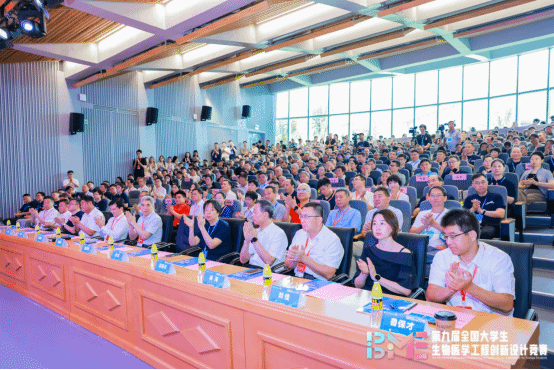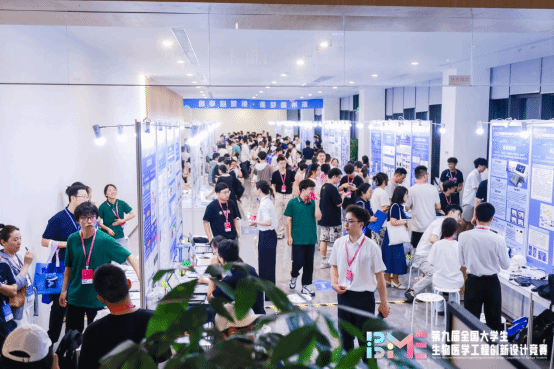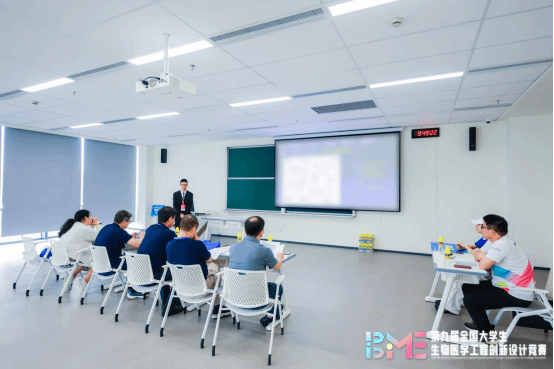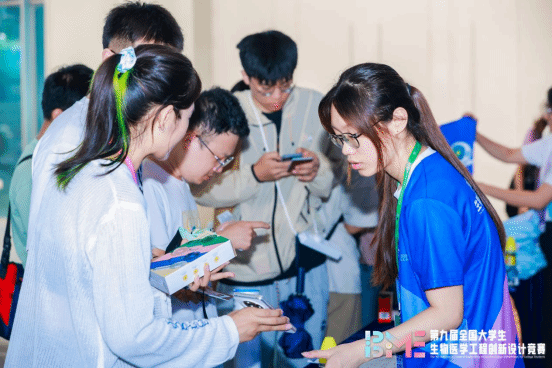After confirming the computer was working properly, the contestants started to introduce their project methodically, displaying PowerPoint slides, explaining their plan and answering with confidence the questions from the panel of expert judges. This was a common scene from the 9thNational Biomedical Engineering Innovation Design Competition for College Students, which lasted from July 22 to 26 at the Sanya Yazhou Bay Sci-tech City. After five days of intense competition, 125 contestants emerged as first-prize winners.
This year’s competition saw unprecedented participation, with nearly 10,000 students and over 2,000 projects from 250 universities across China, including top-ranking ones like Tsinghua University, Peking University, Zhejiang University, Shanghai Jiao Tong University, and Southeast University. The students competed on cutting-edge biomedical topics such as human health, disease prevention, diagnostics, treatment, and rehabilitation.

A Competition Full of Exciting Highlights
New records were set in every aspect: a duration of 5 days, 9 themed activities, 10,000-plus contestants from 250 universities, and 5 academician panelists. Representatives from leading medical device companies such as United Imaging, Sinopharma, and Hamamatsu Photonics, along with Hainan branches of the Bank of China, ICBC, Agricultural Bank of China, China Unicom, China Southern Airlines as well as a host of prominent institutional investors, were also present to scout for ideal projects.
"This year’s competition, hosted by Hainan University (HNU), has the largest number of contestants and the longest duration in the event’s history,” said HNU President and CAS Member Luo Qingming, also chairman of the competition’s organizing committee.

For the first time, the preliminary rounds were held offline. “I am grateful to Hainan University for providing this opportunity to showcase our team’s project, which allows us to connect with more medical device experts, investors, and outstanding peers, and to be better prepared for product optimization and project promotion,” said Gao Chang, an undergraduate student from Nanjing Medical University. The preliminary rounds used to be conducted online, but they are held on site this year, thus allowing participants to engage directly with expert judges and experience the entire process from design to execution and meanwhile enhance their practical skills and team collaboration.
On the sidelines of this competition, the organizing committee arranged a series of themed events. Renowned scholars such as Academicians Cheng Jing, Ma Jun, and Luo Qingming came together for in-depth discussions on cutting-edge topics in biomedical engineering. Leading companies in the biomedical field, such as United Imaging and Tuoren Group, hosted a recruitment drive. A number of prominent institutional investors, industry experts, and academic leaders were also invited to coach the participating teams.
A Fruitful Experience for Contestants

“Since the day we entered the competition, staying up until the early hours of the morning has become a new normal. I’ve lost count of how many late nights I spent with my research papers, falling asleep with my head on the keyboard,” recalled Mo Lifeng, a PhD student from Hainan University. Her team’s constant efforts paid off as they won first prize in the finals.
At the awards ceremony, Mo expressed her excitement: “This is my first time to win a first prize in a national competition, and it means so much to me. During this competition, I have the opportunity to exchange ideas with other contestants in person, learn valuable presentation skills, and gain inspirations from academicians’ talks. The competition is grand and elaborately organized, and as a participant from Hainan University, I felt incredibly proud. Moving forward, I will continue to further my research on the brain-spinal cord-machine interface, with the hope of using our team’s self-developed stimulation chips and devices to aid patients with spinal cord injuries in their rehabilitation and mobility”.
For Sun Yat-sen University undergraduate student Li Zhijun, the competition offered more than just academic achievements: “This event introduces me to the cultural charm of Yazhou as well as its natural landscape of coconut palms and beaches. Yazhou Bay Sci-tech City, as an emerging high-tech hub, has impressed me deeply with its innovations, green development, and smart technology. Besides, Hainan FTP’s talent support policies and research opportunities are quite appealing. I will probably look for a job or start my own company in Hainan after graduation”.
Liang Xingyu, a 3rd-year graduate student from Beijing Institute of Technology, also expressed his gratitude: “I’m thankful for the opportunities this competition has provided, especially the face-to-face conversations with department heads and HR representatives from United Imaging. This experience has helped me know the latest industry trends and technological innovations. It has offered great inspiration for my research project”.
The biomedical engineering discipline has always focused on addressing real-world problems in the healthcare industry. It is hoped that contestants will continue to learn about the latest industry trends, plan their careers with passion and dedicate themselves to the innovative integration of medicine and engineering.
Comprehensive Logistical Support
At the competition site, the volunteers displayed exceptional attention to every detail. Whether it was guiding directions, distributing materials or encouraging contestants throughout the fierce competition, the volunteers were always there to ensure that every participant’s needs were met.

Yang Xiaojie, head of the volunteer team, noted, “For this competition, a total of 500 volunteers have received systematic training, including event operation, facts & figures of Sanya and Yazhou Bay Sci-tech City, volunteer services, communication skills, and emergency responses.”
Wu Xiaodong, Deputy Director of the Suzhou Institute of Biomedical Engineering and Technology under Chinese Academy of Sciences, spoke highly of the event: “First, I want to thank Hainan Provincial Government, the Yazhou Bay Sci-tech City Administrative Committee, and Hainan University. Second, I want to thank every contestant. Third, I want to thank the judges, and finally, my thanks go to all the volunteers who have made this event possible.”
“The organization of the event, the attention from the local government, the participation of so many experts and academicians, and the logistical support from Hainan University all deserve praise. The hotel facilities are well-prepared, and I truly feel welcomed. My special thanks also go to the volunteers, who worked tirelessly every day until late night,” said Shi Yixuan, a PhD student from Tsinghua University.
To ensure the smooth running of the competition, the organizing committee meticulously planned the logistics. They established over 20 management zones, 60-plus operational positions, and a professional operations team. With over 700 posts and 16 responsibility zones, a comprehensive plan involving task assignment, pre-competition training, service procedures, and living arrangements was implemented. “No matter how challenging the tasks, the organizing committee has worked tirelessly to overcome difficulties. Throughout the event they have offered contestants and judges the best possible support to ensure its complete success,” said Zhang Yunzhu, Party Secretary of the School of Biomedical Engineering, Hainan University.
Source from People’s Daily
Translated by Han Yunsheng
Proofread by Kuang Xiaowen, Yang Jie